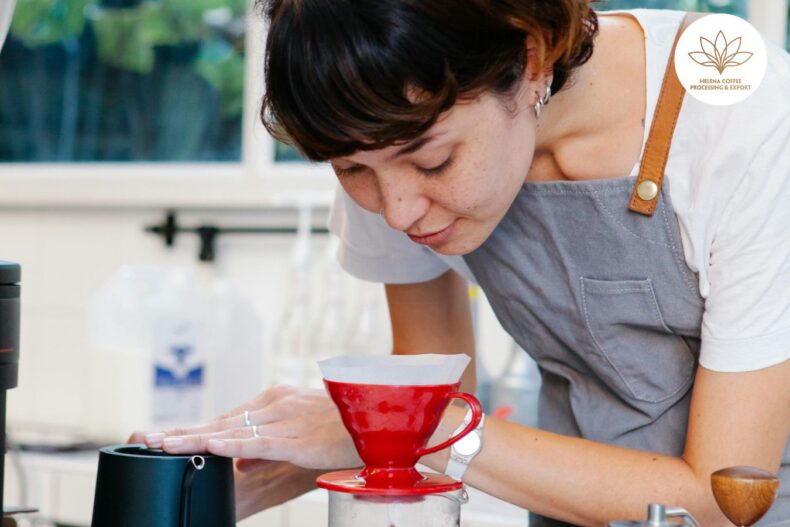
In recent years, oat milk’s popularity in the specialty coffee scene has skyrocketed to such an extent that finding a coffee shop without it is now a rarity.
A 2021 report by World Coffee Portal highlights this trend, showing that 16% of consumers in the UK had enjoyed oat milk in their coffee shop beverages over the past year, marking it as the most favored plant-based milk in the nation. Additionally, the UK saw its oat milk sales more than double from 2019 to 2020, reaching £146 million (approximately US $177.8 million).
But the UK’s embrace of oat milk is just a snapshot of its broader success; this dairy alternative has seen significant growth in markets across Europe, the US, Asia, and Latin America.
This marks a remarkable shift from just five years prior when oat milk was relatively unknown, and almond, coconut, and soy milk dominated the plant-based milk scene.
To understand the surge in oat milk’s popularity and its potential to maintain its leading position, I consulted with three experts from the industry. Here’s what they revealed.
The origins of oat milk when was it first created
The surge in popularity of plant-based milks in recent years is a testament to a growing environmental awareness, particularly among younger consumers. Among these, soy milk has a storied history, tracing its roots back to 14th-century China and achieving commercial production status in the early 20th century across various continents.
In contrast, oat milk is a relatively modern addition to the plant milk family. Its inception in the early 1990s by Rickard Öste, a Swedish food scientist focusing on lactose intolerance and sustainable food solutions, marked the beginning of a new era in plant-based beverages. Öste’s creation led to the establishment of Oatly, the pioneer in commercial oat milk production.
Despite a slow start due to minimal marketing efforts, Oatly’s fortunes turned with the arrival of CEO Toni Petersson in 2012. Under Petersson’s leadership, Oatly embraced a sustainability-driven marketing strategy aimed squarely at millennials. This pivot significantly boosted the brand’s visibility and appeal.
A pivotal moment came in 2017 when Oatly began distributing free samples of its barista-grade oat milk to specialty coffee shops in the US and UK. The product won over many baristas with its neutral taste, creamy consistency, and superior frothing capabilities, leading to its rapid adoption in cafés. This popularity surge caused supply shortages as demand outstripped production capacity.
Following Oatly’s breakout success, numerous brands, including Alpro, Minor Figures, Califia Farms, Pacific Foods, Elmhurst, and Chobani, entered the fray with their versions of barista oat milk, further catalyzing the market’s expansion. The ascent of oat milk has since continued its meteoric rise, reflecting a broader shift towards plant-based alternatives.
What is the size of the oat milk market?
The oat milk sector has seen a remarkable surge in popularity, outpacing other plant-based milks substantially, especially in recent years. In 2022 alone, oat milk’s retail sales in the United States soared by over 50%, reaching a whopping $527.44 million, highlighting its widespread acceptance among consumers.
Pedro Lisboa, who serves as the Head of Coffee Relations at Nude, a leading oat milk brand in São Paulo, Brazil, observes the rapid expansion of the oat milk market, particularly in the US and Western Europe. He notes that in Germany, oat milk dominates the plant milk market, accounting for 60% of sales. Although plant milks represent just 3% of Brazil’s total milk market, oat milk comprises a substantial share of this niche.
The meteoric rise of oat milk can be attributed to several factors. Today’s consumers are increasingly conscious of their health and environmental impact. Oat milk production boasts lower carbon emissions compared to other plant milks. While oat cultivation requires more land than almond milk, it consumes less water. Moreover, the resources needed for producing cow’s milk—both land and water—are significantly greater.
Jacek Walterowicz, co-founder of the UK-based (Un)Ordinary oat milk brand, highlights the environmental credentials of oat milk as a key factor in its popularity. His company sources oats locally in Britain, further minimizing its environmental footprint. The growth in veganism has also played a crucial role in oat milk’s popularity. Data from the German vegan supermarket Veganz shows a doubling of the vegan population from 2016 to 2020, reaching 2.6 million.
Additionally, oat milk’s appeal is bolstered in regions with high lactose intolerance rates, such as East Asia, where between 90% to 100% of the population may experience discomfort from lactose. Despite the traditional preference for soy milk, the oat milk market in Asia-Pacific is expected to grow significantly, at an annual rate of 14.7% until 2026.
The preference for oat milk isn’t just about its environmental or health benefits; its sensory attributes play a significant role too. Daisy Swiers, the UK Country Manager for Califia Farms, points out that many consumers are drawn to oat milk for its neutral taste and creamy texture, reminiscent of cow’s milk. This similarity makes it an attractive option for those transitioning to plant-based milks.
Why has oat milk become a favorite in the world of specialty coffee?
The specialty coffee market has witnessed significant expansion over the past decade and a half, largely buoyed by evolving consumer preferences and innovations in coffee preparation. Pedro notes the sector’s vibrant growth, emphasizing the critical role of milks that enhance rather than mask the intricate flavor profiles of coffee. He highlights oat milk’s natural sweetness when steamed, drawing a parallel to the beloved characteristics of cow’s milk, which has long been a staple in coffee crafting.
Echoing Pedro’s sentiments, Jacek points out oat milk’s remarkable ability to complement coffee’s flavors without overwhelming them. He praises its steaming performance, which yields a creamy, smooth microfoam ideal for crafting coffee beverages.
Despite oat milk’s lower protein and fat content compared to cow’s milk—key components for achieving stable, high-quality microfoam—baristas have found a solution in specially formulated oat milks. These versions incorporate plant-based gellan gum, which interacts with calcium to enhance the milk’s textural properties, allowing for the creation of exquisite latte art.
This innovation has propelled oat milk to the forefront of specialty coffee shops, with notable names like Blue Bottle and Onyx Coffee Lab adopting it as their default choice. Its acceptance has even penetrated competitive arenas, with participants in national Barista Championships incorporating oat milk into their presentations, challenging traditional norms.
Moreover, the Specialty Coffee Association’s recent regulatory adjustments to the World Coffee Championships, including the World Barista Championship, reflect a broader acceptance of plant-based milks. This change underscores the industry’s acknowledgment of shifting consumer preferences towards sustainable and plant-based options.
The rise of plant-based ready-to-drink (RTD) coffee products further underscores oat milk’s growing appeal. With an expanding variety of oat milk-based offerings, including lattes, cold brews, and nitro-infused selections, the market is embracing the versatility and sustainability of oat milk in the specialty coffee sector.
Potential developments and prospects for the future
Pedro is optimistic about the sustained popularity of oat milk but acknowledges several challenges that may impact its growth trajectory. He anticipates the entrance of more competitors into the market, potential shortages in raw materials leading to higher prices, and difficulties in distributing to smaller towns. Regulatory challenges around labeling and marketing, particularly concerning the use of the term “milk” which is traditionally associated with cow’s milk, could also pose obstacles. Despite these hurdles, Pedro is confident that oat milk will continue to dominate the plant milk segment, buoyed by innovation in production and quality enhancements.
Jacek concurs, expecting that the plant milk sector will face challenges in the coming years, yet believes that oat milk will maintain its market leadership.
Daisy points out the consumer health trend as a significant driver for the oat milk market’s growth. She notes the unflagging demand for plant-based beverages that not only offer complete nutrition but also prioritize natural ingredients and lower sugar content. Daisy predicts robust growth for the oat milk market as more consumers transition to plant-based diets, though she cautions that oat milk’s nutritional profile may vary by brand, particularly in terms of calories and sugars.
The introduction of plant milk blends, combining ingredients like oat, soy, and sunflower seed to replicate the texture and creaminess of dairy milk, could also affect oat milk’s market share. These blends are gaining traction for their dairy-like qualities.
Jacek highlights the expanding array of choices for consumers, ranging from small brands offering fresh, bottled plant milks to larger companies that are setting trends within the market.
Pedro contends that the popularity of oat milk shows no signs of diminishing in the near future, despite potential hurdles that could impact its growth trajectory. It’s evident that oat milk has cemented its place as a favorite in numerous coffee establishments globally, and its expansion is expected to proceed robustly in the coming years.
Nonetheless, as the market for plant-based milks becomes more crowded with a plethora of new entrants, the necessity for oat milk brands to carve out a unique identity and maintain competitiveness cannot be overstated.
“With the plethora of oat milk options now available to coffee shops and baristas, it becomes imperative for brands to ensure their offerings are distinctive and appealing” Daisy emphasizes.
FAQs:


